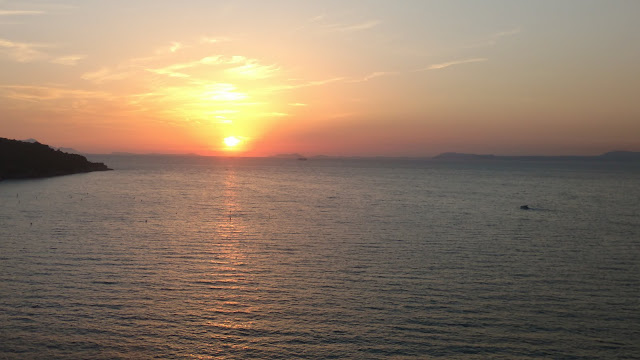 |
| Positano and the vibrant blue waters below |
 |
| pastel colored houses going straight uphill |
through Italy's Gold Coast and at multiple points is simply too narrow for large vehicles to pass one another, each lane having to patiently wait its turn, as one looks out their window at the 500 foot drop below.
Tourism fills the coffers here, and the Amalfi Coast's mild climate, topography, and limited space makes any marketing of the destination extraneous.
Beaches are few and far between (literally) and all of them very rocky. Still, the small areas available are absolutely packed during the summer.
 Food here is farm fresh, with most of the vegetables and fruits served from no more than a few kilometers away. The local specialty is a lemon liquor called "limoncello." It's often sold in bottles imitating Italy's boot-like shape in the world atlas.
Food here is farm fresh, with most of the vegetables and fruits served from no more than a few kilometers away. The local specialty is a lemon liquor called "limoncello." It's often sold in bottles imitating Italy's boot-like shape in the world atlas.Prices here are far more expensive than the rest of Italy as most of the consumption is touristic, coupled with the fact that commerce in the area takes more resources.
 |
| with narrow + steep streets mules are still used to transport goods |
video: interior of Amalfi's 13th century church
But juxtaposed to the natural beauty and ancient relics which act as magnets for the metal coins of tourists, it's easy to spotlight a root of Italy's economic problems. In Salerno consumed by thirst and hunger after a hike, I walked down the the city's main street at 2 PM on a Thursday; all the businesses were boarded up- siesta time.
 |
| the geletaria, the caffe, and another business all shut-down during the early afternoon on a weekday |
Video: gorgeous views along a trail of the Amalfi Coast
Video: a tiny town above the cliffs of on the Amalfi Coast
Video: in Italy, we have water, but we don't waste it- unlike Los Angeles
Video: Thirsty in Amalfi vs. Flint Michigan
 |
| sunset in Sorrento |



The Amalfi Coast is on my Bucket List. I am saving your post to help inform our trip. We have been working through our bucketlist, which you can see at http://adventurousretirement.com/blog/.
ReplyDeletewishing you a great time as you cross locations from your list Wendy :)
Delete